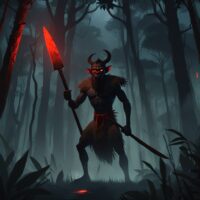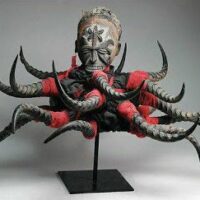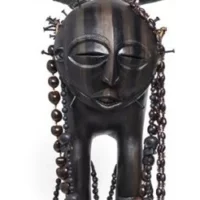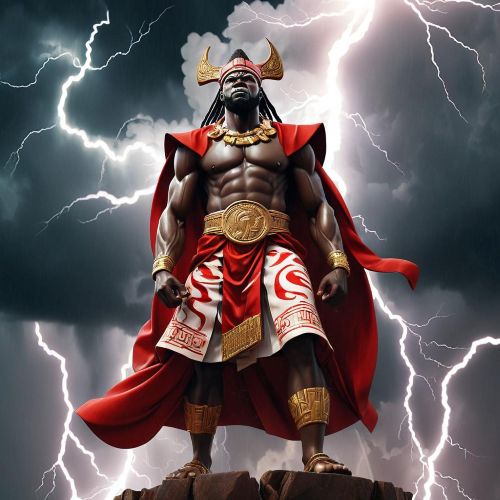Ogbunabali : God of Death
Listen
At a glance
| Description | |
|---|---|
| Origin | Igbo Mythology |
| Classification | Gods |
| Family Members | N/A |
| Region | Nigeria |
| Associated With | Death, Justice |
Ogbunabali
Introduction
In the intricate world of Igbo mythology, Ogbunabali occupies a chilling yet significant role. Known as the deity of death and vengeance, his name translates to “he who kills at night”, immediately evoking fear and awe among those who speak it. Ogbunabali is not a random harbinger of destruction but a divine figure tied deeply to justice and moral retribution. He represents the darker but necessary aspects of order in the Igbo spiritual system, Odinani, where every god and spirit plays a part in balancing life, death, and cosmic law. Unlike deities who bless fertility or protect harvests, Ogbunabali personifies death as an inevitable yet just force, reminding communities that wrongdoing cannot go unchecked. Though Christianity and colonial influence have dimmed the direct worship of many traditional gods, his legend persists, etched into Igbo identity through oral traditions, literature, and even place names.
Physical Traits
Descriptions of Ogbunabali’s appearance are scarce and often symbolic, shaped by oral storytelling and local interpretations. Unlike gods with anthropomorphic forms, Ogbunabali is envisioned more as a spiritual presence cloaked in dread. Some traditions describe him as a skeletal figure with flesh barely clinging to bone, his skull-like face hidden beneath shifting tattoos that writhe like restless spirits. Others speak of him as a towering shadow with piercing eyes that glow red or white, cutting through the darkness of night. Symbols of death, such as owls and bats, often accompany him, signaling his approach to those who fear his wrath. His imagery is not uniform; each Igbo community paints him in a slightly different way, but all agree on his terrifying aura. What remains consistent is the idea that his very form is meant to unsettle the guilty and strike fear into those who have violated sacred laws.
Family
Ogbunabali is not commonly placed within a familial structure in Igbo mythology, unlike deities such as Ala, who is often referred to as the mother of all. Instead, he is seen more as an instrument of higher powers, carrying out the will of the gods and enforcing the moral order of the cosmos. In some traditions, he is considered an agent of Amadioha, the god of thunder and justice, who entrusts him with the grim task of punishing taboo breakers. In others, his connection is drawn to Ala, the earth goddess and moral guardian of the Igbo, whose taboos he enforces through swift execution. While no myths specifically name his parents, siblings, or children, Ogbunabali’s identity is intertwined with the broader spiritual family of deities whose roles intersect in upholding cosmic balance. The absence of a personal lineage underscores his role as a detached enforcer—he is less a familial figure and more an embodiment of divine judgment.
Other names
The core name Ogbunabali dominates most accounts, but regional dialects and cultural variations give rise to alternative titles. Some traditions call him Onye Ndu N’Abali, meaning “the bringer of death at night,” which captures his nocturnal essence. In other contexts, he is associated with Ekwensu, a spirit often linked with trickery, chaos, and gruesome vengeance. While scholars debate whether the two figures are the same or simply overlap in certain qualities, the association reflects how Igbo mythology often blends and shifts depending on oral traditions. Additionally, in Ikwerre culture, a name sounding similar to Ogbunabali refers to a historical pair of men who founded a community rather than a god. This difference illustrates how language and geography shape interpretation. Just as Amadioha has different appellations across Igbo regions, Ogbunabali too carries varied names that reflect his fearsome reputation while highlighting the richness of Igbo linguistic diversity.
Powers and Abilities
The powers of Ogbunabali are tied directly to his role as the divine executor of justice. His most feared ability is delivering death during the night, when the guilty are most vulnerable. Unlike chaotic spirits who strike at random, Ogbunabali acts with chilling precision, targeting criminals, taboo breakers, or anyone who has violated the moral and spiritual codes upheld by the Igbo people. His justice is immediate, brutal, and unquestionable.
Legends emphasize that he is invisible to the ordinary eye, though his presence can be felt through signs—unusual animal cries, sudden paralysis, or overwhelming dread in the hearts of wrongdoers. Oaths sworn in his name are binding, and breaking them is believed to invite instant death. In literary depictions, such as Elechi Amadi’s works, characters swear by Ogbunabali as a testament to his fearsome authority. Beyond the act of killing, his power lies in embodying a moral compass that enforces accountability. He is not chaos incarnate; he is divine order’s sharp edge, ensuring no crime goes unpunished.
Modern Day Influence
Though the rise of Christianity diminished open worship of traditional Igbo gods, Ogbunabali’s presence has not disappeared. Instead, he has transformed into a cultural and symbolic figure. In Igbo literature, his name carries weight as a reminder of traditional justice systems rooted in spirituality. Writers like Elechi Amadi immortalize him in novels, portraying him as a powerful force shaping decisions, disputes, and community life. These works ensure that modern readers and scholars remain connected to his mythos.
His influence also extends into geography, with places like Ogbunabali in Port Harcourt carrying his name. Such names keep his legacy alive in daily conversation, embedding him within Nigeria’s cultural landscape. Even urban legends and folktales circulate stories of mysterious deaths linked to him, reflecting how myths adapt to modern settings while preserving their core meaning.
In recent years, Afrocentric spiritual movements and neo-traditionalists have revived interest in deities like Ogbunabali, framing him as a symbol of ancestral justice and resilience. In Nollywood films and African horror fiction, he appears as a spectral enforcer, bridging myth and entertainment while reintroducing younger generations to Igbo spirituality. Beyond superstition, the concept he represents—divine justice delivered without mercy—still influences moral consciousness in Igbo society. Even in predominantly Christian communities, the fear of ancestral spirits like Ogbunabali continues to shape discussions of ethics, taboos, and justice.
Related Images
Source
Achebe, C. (1958). Things Fall Apart. Heinemann.
Basden, G. T. (1966). Among the Ibos of Nigeria. Frank Cass & Co. Ltd.
Echeruo, M. J. C. (1979). Igbo Mythology and Religion. University of Nigeria Press.
Ilogu, E. (1974). Christianity and Igbo Culture. NOK Publishers.
Nwoye, G. (2011). Igbo cultural and religious worldview: An insider’s perspective. International Journal of Sociology and Anthropology, 3(9), 304–317.
Umeh, J. A. (1999). After God is Dibia: Igbo Cosmology, Divination & Sacred Science. Karnak House.
Mbabuike, M. C. (1996). The cosmology of Igbo anthroponyms: Life continuum and liturgy of culture. Dialectical Anthropology, 21(1), 47–65. Retrieved from https://www.jstor.org/stable/29790419
Oriji, J. N. (2009). Transformations in Igbo cosmology during slavery: A study of the geneses of place-names, totems & taboos. Cahiers d’Études Africaines, 49(4), 953–967. Retrieved from https://www.jstor.org/stable/40380044
Centre for Igbo Studies, University of Nigeria Nsukka. (2025). About the Centre. Retrieved from https://www.unn.edu.ng/academics/centres/centre-for-igbo-studies/
Frequently Asked Questions
What is lorem Ipsum?
I am text block. Click edit button to change this text. Lorem ipsum dolor sit amet, consectetur adipiscing elit. Ut elit tellus, luctus nec ullamcorper mattis, pulvinar dapibus leo.
What is lorem Ipsum?
I am text block. Click edit button to change this text. Lorem ipsum dolor sit amet, consectetur adipiscing elit. Ut elit tellus, luctus nec ullamcorper mattis, pulvinar dapibus leo.
What is lorem Ipsum?
I am text block. Click edit button to change this text. Lorem ipsum dolor sit amet, consectetur adipiscing elit. Ut elit tellus, luctus nec ullamcorper mattis, pulvinar dapibus leo.
What is lorem Ipsum?
I am text block. Click edit button to change this text. Lorem ipsum dolor sit amet, consectetur adipiscing elit. Ut elit tellus, luctus nec ullamcorper mattis, pulvinar dapibus leo.
What is lorem Ipsum?
I am text block. Click edit button to change this text. Lorem ipsum dolor sit amet, consectetur adipiscing elit. Ut elit tellus, luctus nec ullamcorper mattis, pulvinar dapibus leo.










